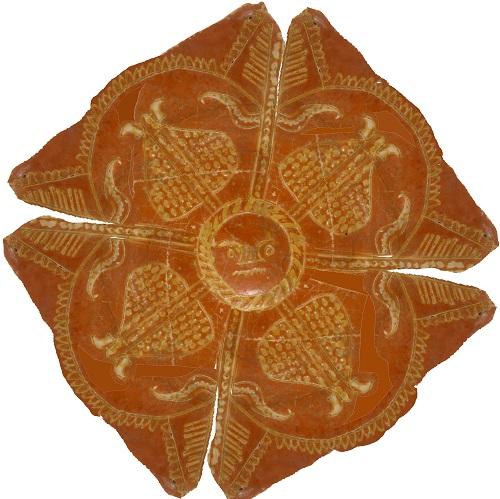A plate full of meaning

Today we have a guest blog from Jeff Speakman, Assistant Curator at the Museum of Liverpool.
‘Excavations at Rainford Tennis Courts in St Helens in 2015 revealed an amazing range of locally-made pottery. One piece which really stood out was a plate or shallow dish, with a scratched-in ‘sgraffito’ decoration. This mid- to late-17th century plate is decorated with a central face with radiating lines and fruit or flowers and leaves.
It is really unusual, very few of the other finds from Rainford Tennis Courts are decorated, and those which are don’t have such elaborate designs. This has made us wonder whether this item was made in Rainford or not? In the early 17th century, ‘sgraffito’ decorated pottery was made at a number of places around Britain (and also in Europe). It was particularly common in North Devon, but was also produced in large numbers at Donyatt in Somerset and Buckley, in North-East Wales. Most are made from a reddish clay body, which is covered with a thin layer of lighter clay ‘slip’. This lighter slip is then scratched off in areas to create the design. Our example from Rainford is the opposite, a light-coloured clay plate with a layer of darker slip, scratched away to create a design in the lighter colour.
There are a few quite similar examples which were made in ‘the Potteries’ region of North Staffordshire. This hints that our plate was made in north-west England, quite probably in Rainford itself, and may have been a special commission ‘made to order’ for a customer.
The design on the plate has also got us thinking – there might be a lot of interesting symbolism in there!
In the Netherlands, analysis of decorative designs has been used to suggest that potters used the images as a form of ‘picture-writing to communicate ideas to the illiterate masses’ (Gwarthoff-Zwaan and Ruempol 1988). These vessels were often decorated with popular religious symbols, and icons associated with fertility, regeneration or defence against evil.
On the Rainford plate there is a central face. This is encircled by a rope-like circle and four repeated shapes, which may be pomegranates cut open to reveal the seeds. These are interspersed with leafy shapes, potentially palm fronds. The design on the outer edge of the vessel does not survive with any certainty and the rim, which may have a contained further decoration, a motto or inscription is completely missing.
Religion, primarily Christianity, was a central cultural and social structure in medieval and post-medieval Britain. There was a shared range of symbols, prayers and beliefs which everyone would have had some understanding of, whether they could read or not.
- Face – the simple free-hand face motif, may represent the sun a symbol of Christ, the son of God, who brought light into the world (John 8: 12).
- The rope circle – The surrounding circle was often used to represent eternity.
- Pomegranates – A widely used motif during the 16th and 17th century as symbols of the resurrection or of fruitfulness/fertility, as the pomegranate produces lots of seeds.
- Palm fronds – a symbol of victory of the faithful over the enemies of Christ, with many leaves angled towards the stem.

After the ‘reformation’ in Henry VIII’s reign, Catholic practice was increasingly extinguished and churches were stripped of much imagery. The 1549 Act of Uniformity banned the Mass and royal officials travelled the country to enforce the new laws. However, Lancashire retained a strong Roman-Catholic community, with the 1767 ‘Returns of Papists’ listing more than 40% of all English Catholics living in the County. It’s possible that objects like this plate represent people who continued to follow Roman-Catholic symbolic traditions into the 17th century and beyond. As the Puritans took stronger control it would have been dangerous to use objects that proclaimed these Catholic beliefs, let alone to have produced those wares. Indeed in 1660 a Rainford potter, John Bispham, was taken forcibly whilst attending a Quaker meeting at Bickerstaffe and imprisoned in Lancaster Castle for nine weeks for refusing to take the oaths of allegiance to the new faith (Leadbetter 1992).
Whilst it is possible that the plate’s design might be purely decorative, as archaeologists we’re always keen to try to understand what someone was thinking, and how they used objects which survive, and why they made things the way they did, and we have our suspicions about this one!
Was it made for private use? Was it made for a secretly travelling Roman-Catholic priest so he could spread the message of the ‘one true’ faith to the illiterate masses and maintain the faith whilst it was illegal to do so? Indeed a number of such priests including men from Lancashire, such as Edmund Arrowsmith, from St. Helens, were hanged drawn and quartered as punishment!
Or is it just a pretty plate?!
References
Gwarthoff-Zwaan, M. and Ruempol, A. 1988. Exhibition Catalogue – Communicerende vaten Beeldtall van slibversiering op laat-middeleeuws aardewerk in de Nederlanden. Uit de collective Kunstnijverheid en Vormgeving Museum Boymans-van Beuningen. Rotterdam.
Leadbetter, F. 1992. The Leadbetter Papers. Privately published.
